
|   |

|   |
 e-mail: leelakaverivenkat@gmail.com Margam is ever new March 21, 2017 One of the highlights of a superbly mounted, third consecutive annual two-day Sindhu Festival in Pune by 'Sankhya' headed by Bharatanatyam artist Vaibhav Arekar, with its thematic accent this year on the Margam, was the dancer's own solo presentation - premiering a centerpiece comprising Poochi Srinivasa Iyengar's Varnam strung in raga Vasantha and tala misra jhampa. "Dani korikenu niraverchutakide tagina samayamu, raa tamarasaksha," pleads the sakhi with Lord Vishnu conveying to him her friend's message, entreating that he hurry to her to assuage her pangs of love, for the time is ripe for their union. "Dayadoochi dani," she begs for his compassion to answer her friend's call forthwith. Supported by an excellent team of musicians led by nattuvangam by Kaliswaran Pillai (son of Kadirvel Pillai), melodious vocalist in G. Srikanth, taut mridangam accompaniment by Satish Krishnamurthy and impactful interventions on the violin by Narayana Parthasarathy, Vaibhav treated the audience to the grandeur of Bharatanatyam nritta and interpretative dance at its best. The theme is as old as the varnam though its translation in Vaibhav's myriad danced images was anything but hackneyed. What was so stirring about the dancer's presentation was the manner in which all awareness of body physicality and the performer's gender were transcended. What one experienced was the image of unrequited love which, the passionate case made out by the friend, with the persuaded loved one making his way (to the beloved) with the closing image of a deep embrace with both arms wound round the dancer posing with back to the audience. To be able to see new images in time-honoured traditional songs requires the creative mind which alone can rise above the oft-voiced query: "Is the Bharatanatyam Margam outdated and irrelevant in the present situation?" Also very unusual was the treatment meted out to the Tillana in Poorvi, a composition of Tirugokkaranam Vaidyanatha Bhagavatar with G. Srikanth starting the alaap in Poorvi, gradually expanding its contours with the dancer's movements similarly acquiring a sense of spread and occupying greater performance space. Equally exiting were the permutations and images woven into group presentations in what was called the Retrospective, featuring Vaibhav with his disciples. The Alarippu with its extraordinary architecture of lines acquired another original face in a group presentation on the round. The brief tableau, visualized in the Bharatanatyam body language, depicting the Karna/Kunti dialogue before the war (a scene from the ambitious Mahabharat visualized in a blend of dance forms directed by Shama Bhate) presented once more the suggestive power of just one gesture of Karna becoming a pregnant pointer to the entire Karna/Kunti story - namely, the desperate hand of Karna stretching trying to catch the hand of the escaping mother, rejecting claims of motherhood (letting her baby afloat in the river in a basket) to save herself from societal censure. The advantages of brevity and quietude in Vaibhav's abhinaya based compositions were clear in the Virahini's desolately empty attitudes and bleak faces in the Sant Gyaneswar Abhang "Krishne vedini virahini bole", full of flashing images of the nayikas bemoaning the absence of the loved one. So too the Grishma scene inspired by Kalidas' Ritu Samhar vividly communicated images of slowly sapping energy of the wilting animals during the torrid heat of summer. An example of how abstract ideas of mind, buddhi, chitta and ahankar based on a sloka from the Upanishads could be communicated through body movements in group imagery was again a challenge handled very successfully. Ideas like Shuddha Gyan, Atma, the awakening of the energy chakras in the body till the sahasra chakra, with Kundalini shakti activated were conveyed evocatively. C.V. Chandrasekhar's jati based on the sound 'Aham' was a brilliantly original way of showing the eradication of the ego or self before one attains the exalted state. Aesthetic costumes and subtle lighting effects by Sushant Jadhav added to the presentational strength. Slide show Photos: Kaustubh Atre & Kishor Gumaste 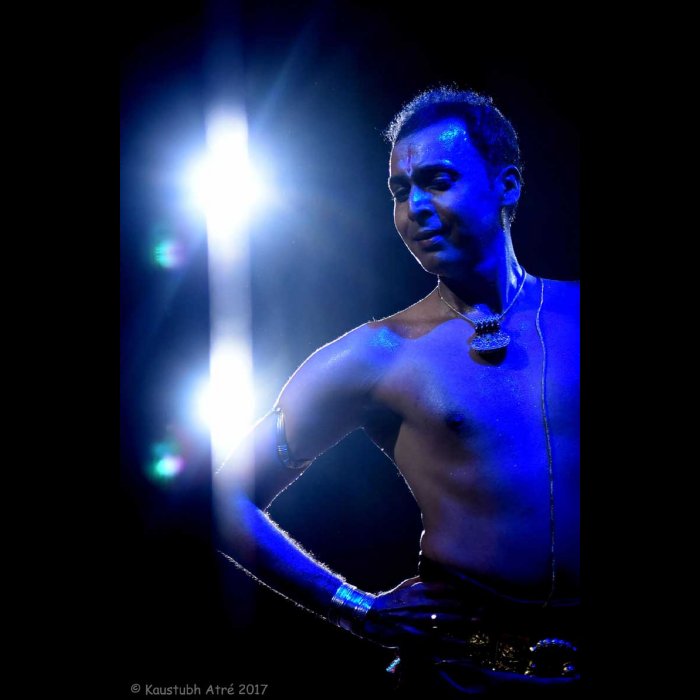
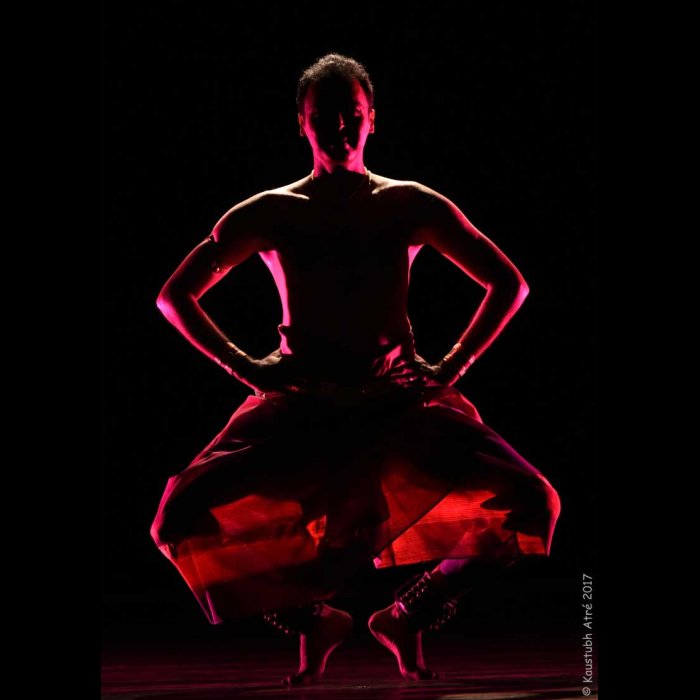
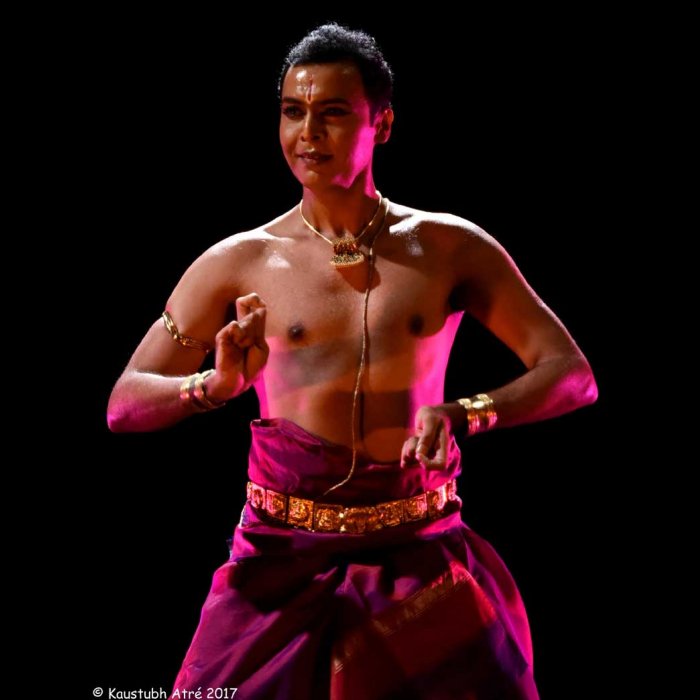
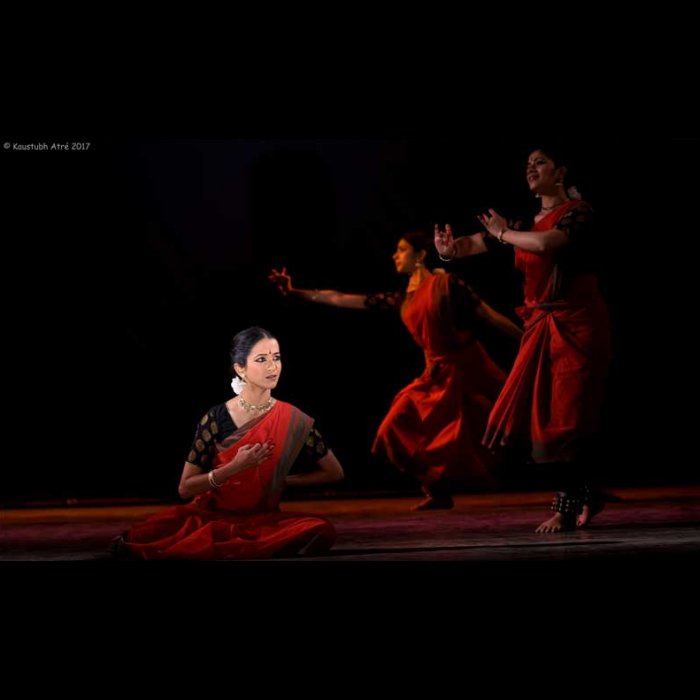
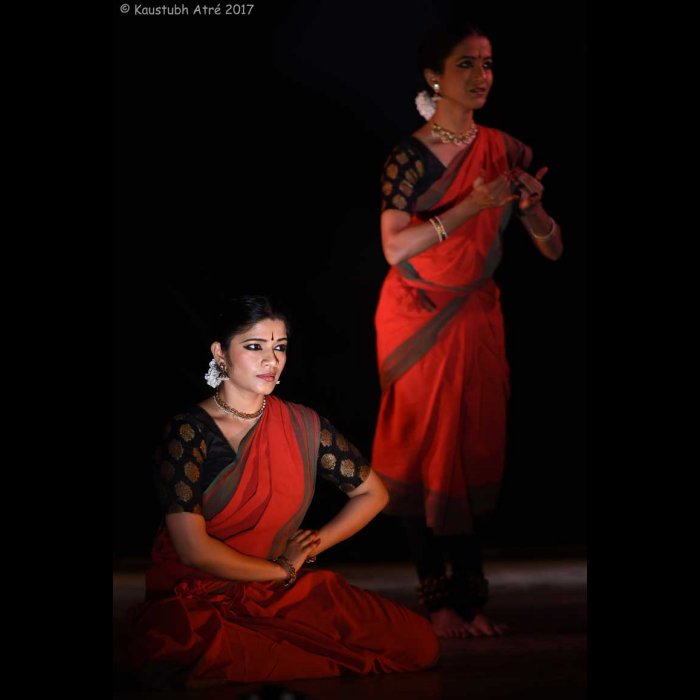
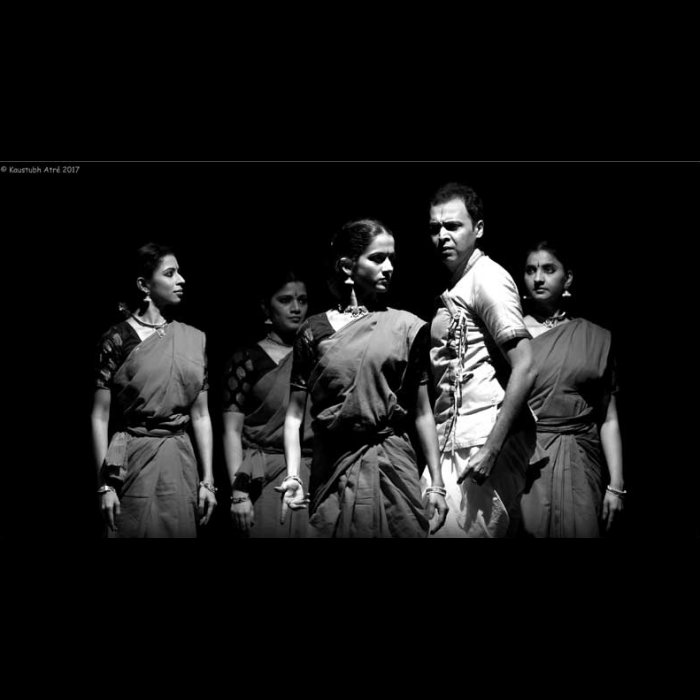
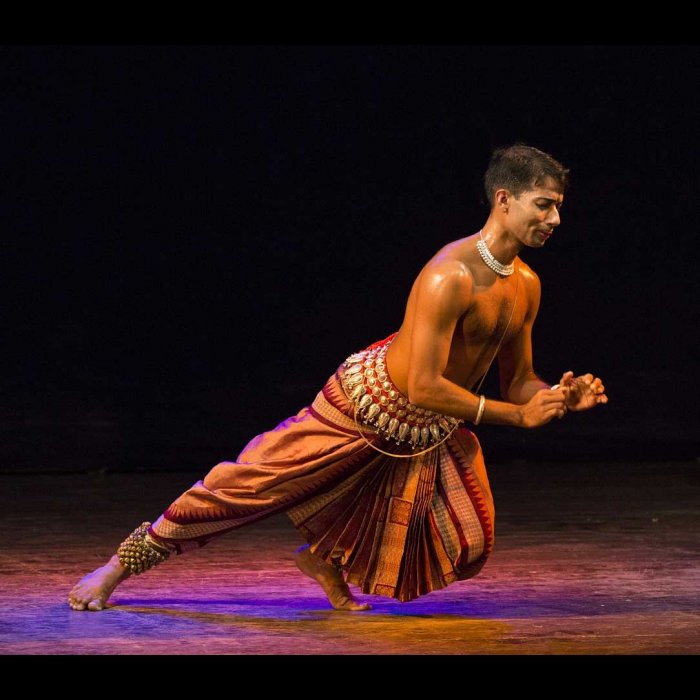
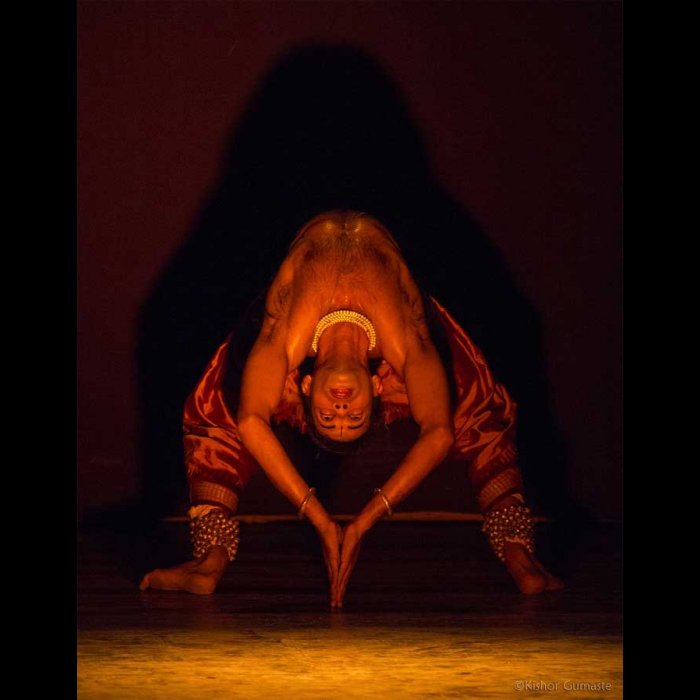
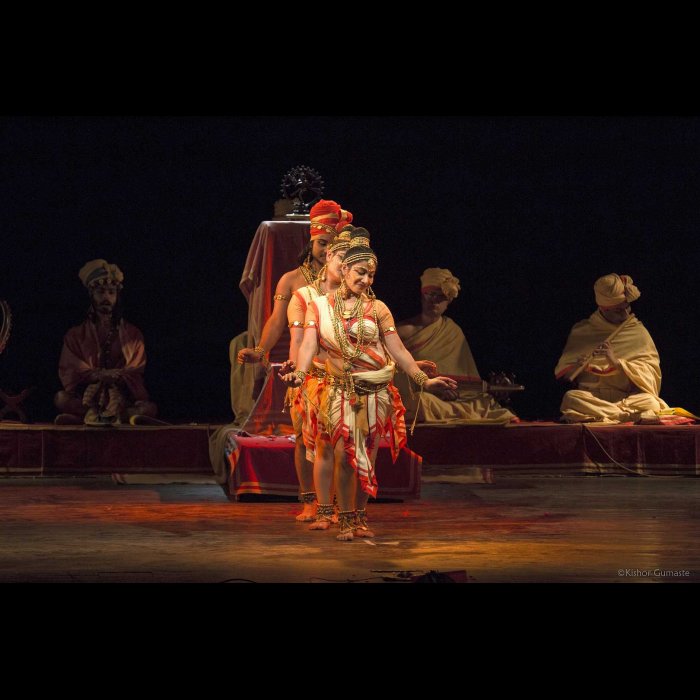
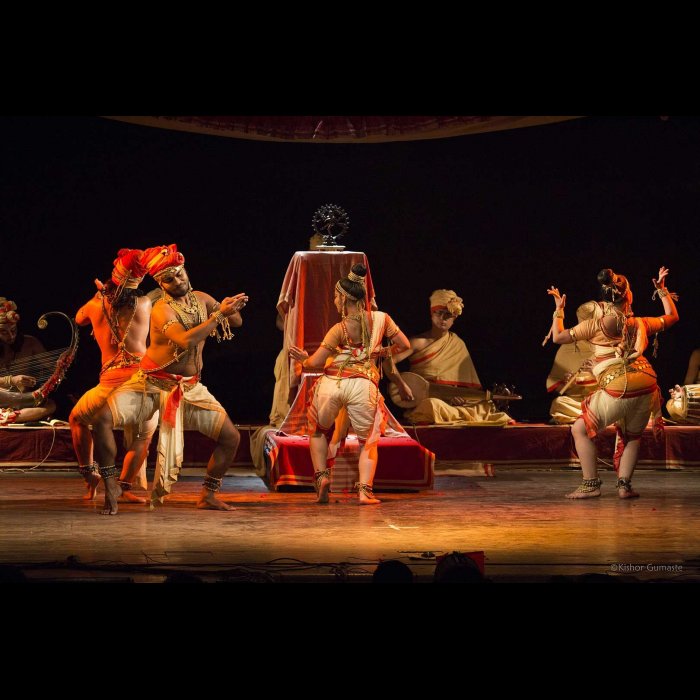
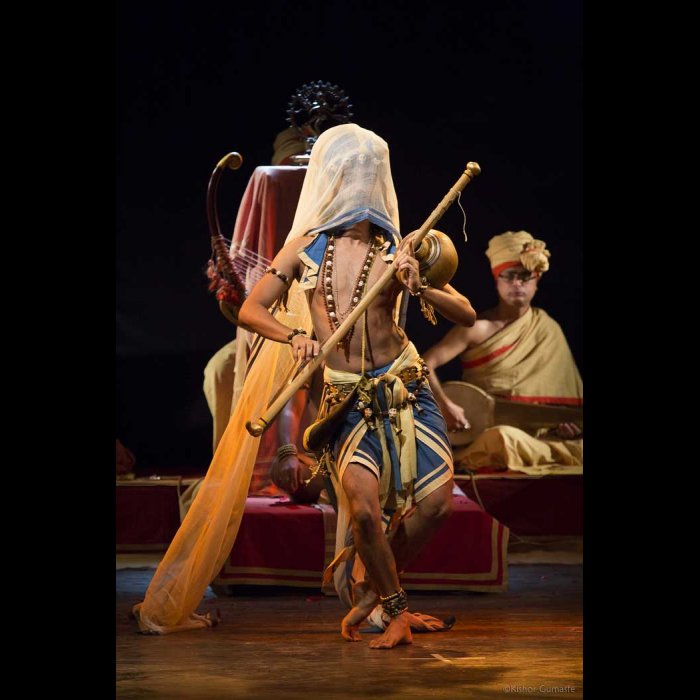
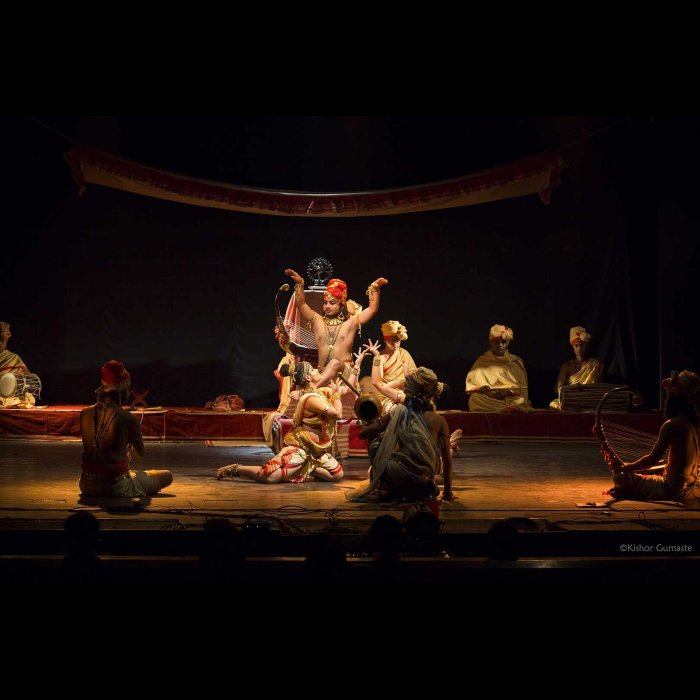
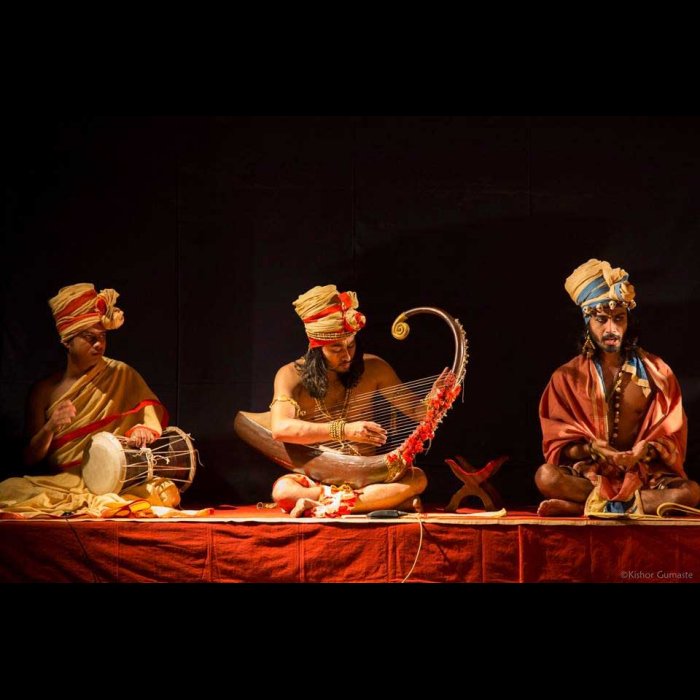
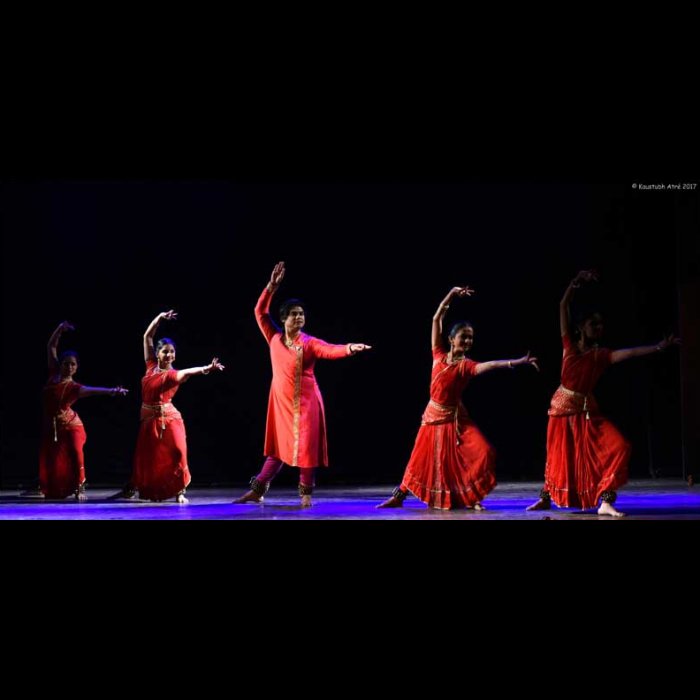
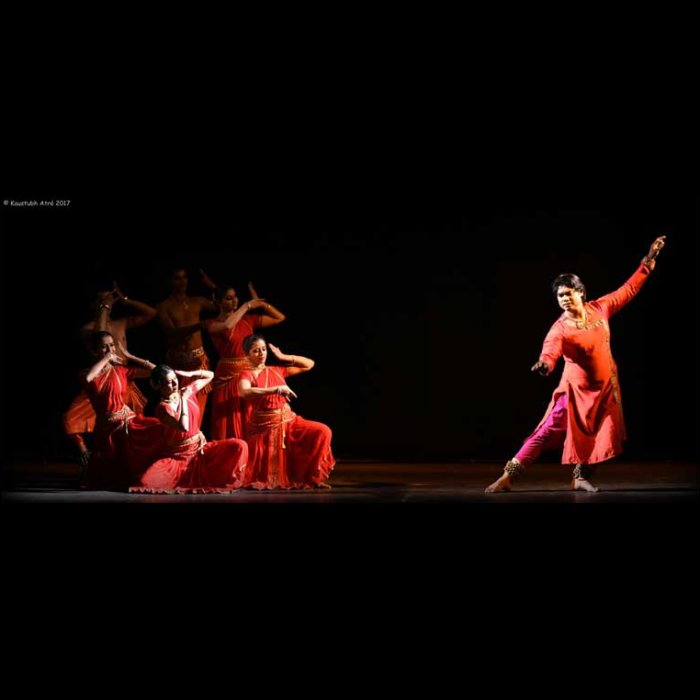
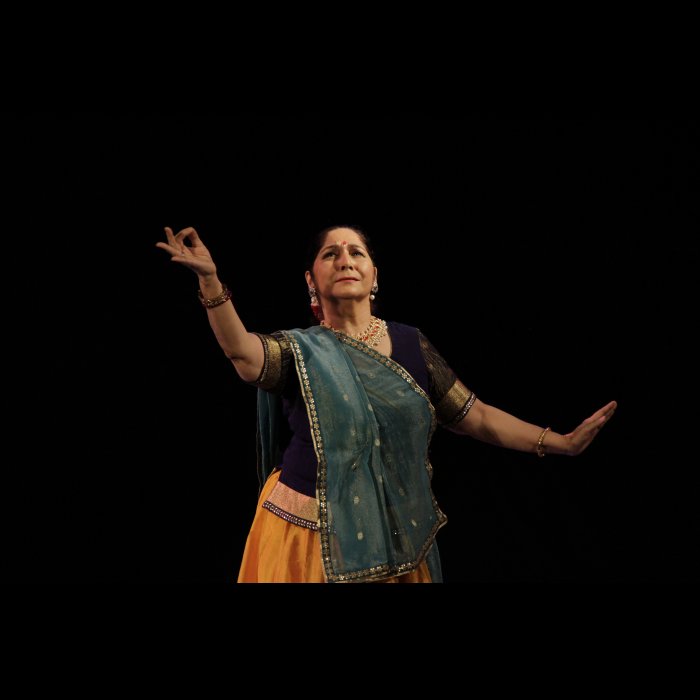
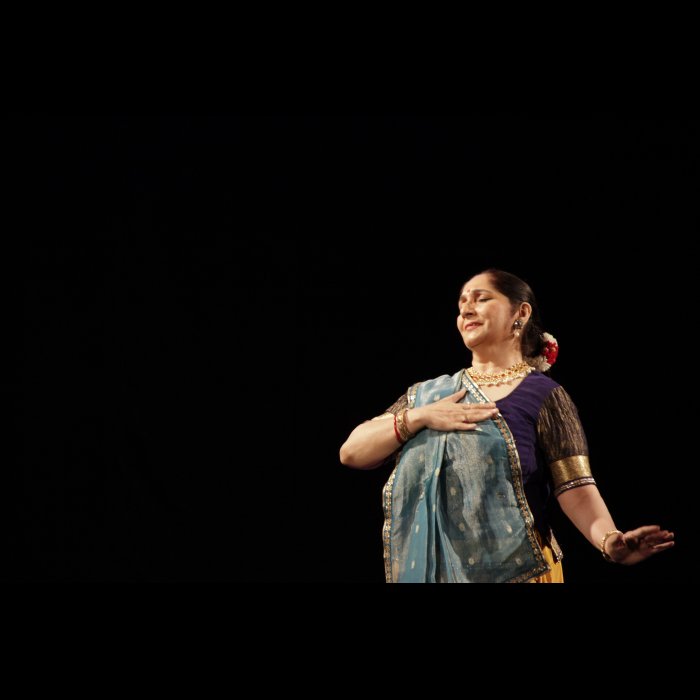
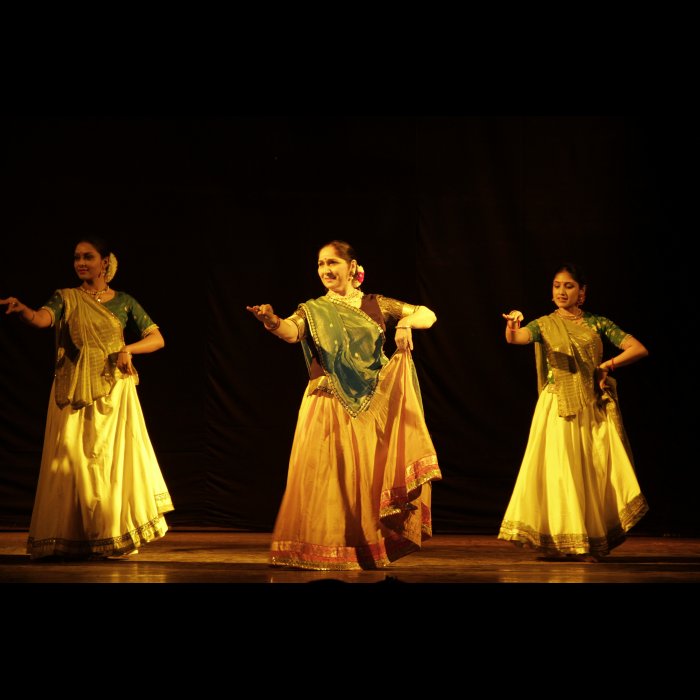
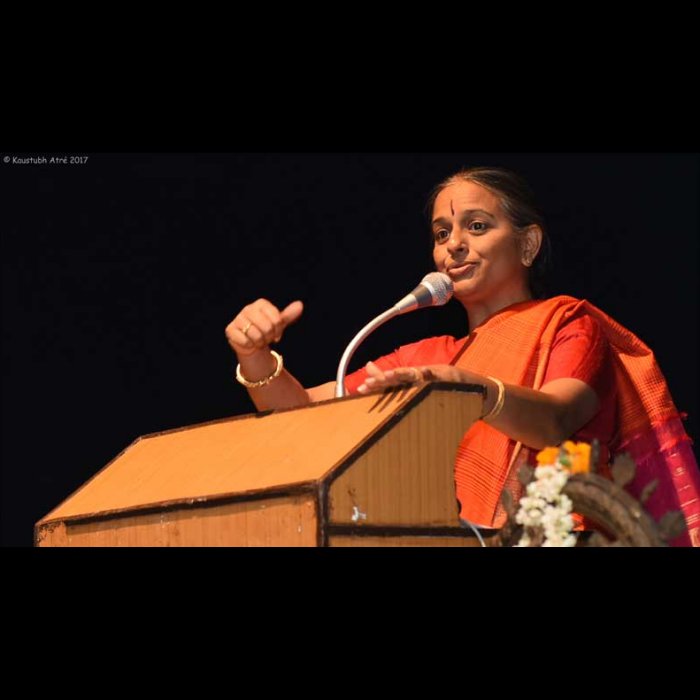
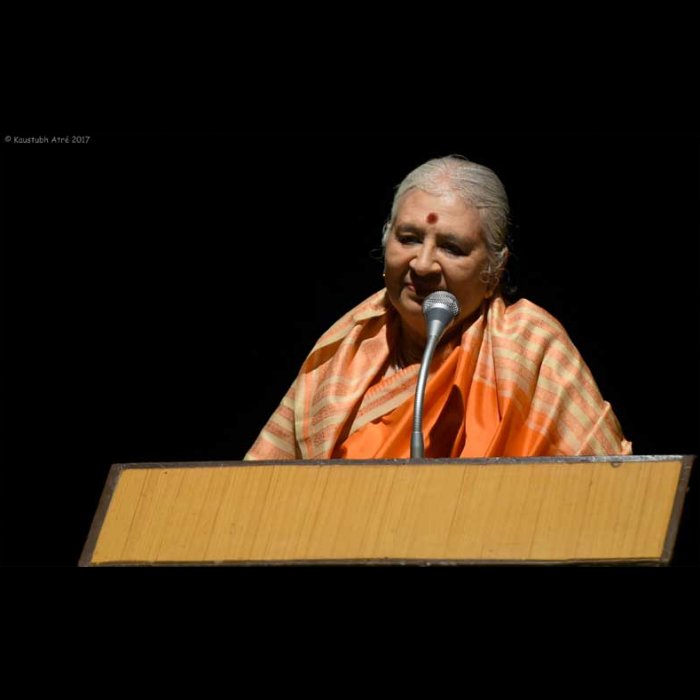
Odissi of Debaprasad vintage Though rendered to recorded music, it was gratifying to watch Odissi dancer Rahul Acharya who seems to have regained his original form, after a period of inexplicably listless performing. The curtain raiser with the Vishwanathastakam prayer and Ravana's Shiva Stotram, was followed by what this critic considers to be the best of late Guru Debaprasad's (Rahul is the disciple of this guru's disciple Durgacharan Ranbir) creations namely Sthai based on rhythmic syllables set to tune in Shankarabharanam. This acme of Odissi nritta while very neatly rendered lacked a broad plie or chauka. When asked, the dancer insisted that that is how it is represented in sculpture and that the square stance has no place here. The fact that it had in the Guru's visualization, one presumes is no longer important. It is creditable that with inputs from Sanskrit scholar Nithyananda Misra helping the dancer with the finer aspects of the Geeta Govinda ashtapadi "Priye Charusheele" sung in raga Desh, the dancer's own interpretation had conviction in the abhinaya. Durgacharan Ranbir's dance visualization for Sooryashtakam with music in raga Bairagi and tala roopak, was rendered as the concluding item. Rahul competently introduced his own items in lucid English. Kathak with a difference The inner dancer is invariably revealed in a dance performance, and starkly so in the case of Uma Dogra who seems to have imbibed some of her guru Durgalal's sincerity of purpose and a certain unsullied purity of mind - though her Kathak does not reveal the usual virtuosity and rhythmic grandstanding which is commonly exhibited today. What is more, with her aptitude for composing poetry, she seems to have a preference for interpretative dance which is minimally treated in most Kathak performances. But she showed with her students some of her guru's favourite tukras. Residing and teaching in Mumbai has made the Abhanga ('Sundar Dhyan') a favourite in her presentations. Every act reminds the nayika of images of her beloved Krishna, and in his absence the struggle is like the fish threshing about without water. Music composition by Shailendra Bharatiji in Varsha Ritu saw the birds, the peacock with the Mayur gat images with the Sargam and the Tarana also thrown in. It was rendered by the group with feeling. Uma's own evolution as a dancer through her own interpretation of the ashtapadi "Dheera Sameere" (her guru was not given to doing abhinaya himself, and she was too young when he passed away) had an individual twist in that the sakhi who tries to persuade Radha to throw away her pride and join Krishna who waits for her, eagerly imagining her footsteps in each feather fall or stirring leaf, is herself deeply in love with Krishna. In a case of 'sudhabhakti', in a vicarious way she believes that her sacrifice in procuring Krishna's love for Radha would fulfill her. "Go Radha, like white cranes on a dark cloud, your garlands rest on Krishna's chest. On the wind swept banks of the Jamuna, Krishna waits in wildflower garlands, go". The music in Megh was sung by Alap Desai. There was an internalization of emotions that made the presentation moving. Wonder of Marga Natya Occupying top billing in the festival was Marga Natya presented by Chitrakash Kalalay (Centre of art and divinity) by Piyal Bhattacharya and his ensemble. The result of 17 years of arduous research by Piyal Bhattacharya, an alumnus of Kerala Kalamandalam, no effort has been spared in working towards his ambitious goal of trying to reconstruct the ancient Marga Natya, as presented in the time of Bharata and mentioned in the Natyashastra. Chitra Poorva-Ranga is the extraordinary amalgamation of dance and music in a ritualistic manner wherein song is the mantra and the dancer's body the naivedya, offered to the Gods and spectators. The act symbolises cosmic creation though the elements of Agni (fire) and Soma (causal matter) and their interplay through the vibration of music including swaras and stutis with the dancer's body responding to it. Action begins with playing the tri-sama or tri- Pushkara or triadic percussion system mentioned in Natya Sastra - Urdhaka or Maha ghatakara, Ankika which is placed on the lap and played and Alinga where the instrument is held under the arm. There is a gradual expansion of tri-sama after which come instruments like Mattakokila and Kacchhapa veena and the Shushkakshara (syllables devoid of meaning). This is followed by the Asarita-Vardhamana Vidhi which is rendered to Shiva Stuti in shuddha and misra jati. The gyrating bodies of the dancers represent the dance of the cosmic bodies during manifestation. The eight cosmic forms of Shiva, Bhairava roopa and bhoota ganas with the dancers finally offering their bodies are represented through nritta in Natyashastra - which is the first pulse or Jagat Karana with Natya as Jagat Karya and tala representing expansions of pulsations. The pindis or formations like lata representing sutratma, the shrinkhalika representing the locking of luminous flames, gulma and bhedyaka representing contracting and expanding energy formations in the creative process are expressed through the gyrating damsels. As soon as three of them enter the stage, though one felt a culture shock - in the costuming (by Chhandak Jana) with the kati movements, which the superficial eye will consider as vulgar - till the realization sinks in that the bhangis of this nritta with the spiral movements of the kati have a symbolic meaning, showing the rajoguna or dynamic forces potent within creation getting split with the tribhanga which signifies the imbalance of Satva- Rajah-Tamah, with the atibhanga suggesting gross manifestation of cosmic materials. The spectator soon discovers that when the intent is different and pure with not the faintest idea or sign of trying to titillate, the action of the kati cannot evoke vulgarity - nor can the costumes made of fine muslin and dyed in natural colours to fit the vision of the presentation. The ornaments are of light wooden beads metamorphosed by covering of lacquer plated with 24 carat gold foil specially procured from Myanmar. The speaking part which can be on worldly or alaukika (other worldly) makes an appearance in the Bhaanaka. Here the Sutradhara who is Shaivite and is considered Sarvagna Chaitanya is introduced. He is Alapini dhara (ancient one stringed stick dhara) Shiva which the Sutradhara holds on his body and he is the core of the Natya and each step of his is to cut the veil of Agnana or ignorance. The medium of song (sapta kaala geeti) is used to represent the 7 musical notes, the 7 dimensions of consciousness and the 7 vortices of energy (sapta chakras) in the body. The triangular choreography represents three devis, Maha Saraswati, Maha Kali and Maha Lakshmi of Gandharva vidya - wherein svara is Saraswati, tala is Kali and sahitya Ambhrini vaak is Maha Lakshmi. While the entire dancing cast of Akash Malik, Pinki Mondal, Deep Ghosh, Rinki Mondal and Manjira Dey was excellently trained, Sayak Mira as the Sutradhar was truly brilliant - his movements, his acting, his recitation of Sanskrit done with a masterly touch - the power of his performance keeping the audience in raptures and in another world. The point is that the acting was so persuasive that even for an audience with no expertise in Sanskrit every gesture of the action was clear. This alaukika treatment has nothing from scripture or sculpture, but is 'Muni vachana Anukirtana'. In the beginning the music had a dhrupad like minimal quality and the repetitive chanting like notes almost ushered in a soporific feel transforming the spectator's mood. To procure instruments resembling the Urdhaka, Ankika and Alinga percussion, the old harp like instrument - the Yazh - and other instruments must have been a herculean task. The way the musicians were seated on a platform on the floor over which a veil was held was highly individualistic. The Anukirtana or glorious retelling of the tattva or Reality, which formed this universe is what the presentation is about. When the performance ended with Bharat Vakya or benediction for happiness and joy to people and balance of agni-soma in the environment, the entire audience stood as one man applauding the extraordinary performance. Apart from the performance aspect, the fact that morning lecture sessions on Yoga and dance by Jyotsna Narayanan and on the Marga relevance today, also saw handsome audiences, shows that there is a discerning Pune audience for dance - missing in most cities.  Writing on the dance scene for the last forty years, Leela Venkataraman's incisive comments on performances of all dance forms, participation in dance discussions both in India and abroad, and as a regular contributor to Hindu Friday Review, journals like Sruti and Nartanam, makes her voice respected for its balanced critiquing. She is the author of several books like Indian Classical dance: Tradition in Transition, Classical Dance in India and Indian Classical dance: The Renaissance and Beyond. Comments * I had the honor of being invited to Vaibhav Arekar and Sushant P Jadhav's prestigious Sindhu Festival in Pune. After my performance, Piyal Bhattacharya from Kolkata presented 'Marga Natya' showcasing the Margi tradition of the Natya Shastra. In my three decades of dance and having travelled the world being exposed to various art forms, never have I seen anything like this before. How do you feel when you realize that all your work so far is not even a sand particle compared to the mammoth task, people undertake to surrender themselves at the feet of Sangeeta? For the entire one and a half hours of the production, I was transported to Swargaloka, being only a mere mute spectator to the profoundness of dance being presented by the Apsaras and Gandharvas. It was as if nothing existed. It was like Tandu imparting lessons on Angahara to Bharata. It was like Nandi playing to Shiva and Parvati, performing Tandava and Lasya. I was cleansed, purified, rejuvenated. Piyal Da has recreated the entire Margi form of the Natya Shastra in its pristine style and presented it as mentioned in the text. The use of the Karanas, Rechakas and Angaharas was impeccable, with every minute details of the hasta Karana and Kati being performed with great finesse. Not only the dance, but he has taken great pains to recreate the Sangeeta lakshana khanda using the same music patterns of the sapta swara and Ukutas as mentioned in text. What a humongous task to recreate the musical instruments that are found in the text like the eka-tantri Veena, the mridanga, dardur, kachhapi veena, alinga etc, not only this, he had made his musicians learn to play those instruments and perform live during the production. The role of the Sutradhaar was outstanding, showcasing the Natya aspects. What command of Sanskrit and Hindi. What amazing body language, what perfect rendition of the dialogues. Every aspect of the Natya Shastra commencing with the Purvaranga, Pushpanjali etc, the presentation of the uddhata and Lalita prayogas, even the auditorium was recreated to form a Natya Shastra styled agraharam. I just tried to explain the inexplicable, one need to see it to believe it. - Rahul Acharya (March 21, 2017) * A reconstruction of the Marga Natya tradition based on the Natya Shastra and its many commentaries! What a fabulously interesting and mind blowing performance by scholar, researcher Piyal Bhattacharya's group! This is easily the most original performance that has come out of Bengal in over a decade! Amazing depth of research, smart adaptations of text to movement enacted by an extremely talented team of actors and dancers! I could watch this production all over again, several times! I have never been more impressed by any art form from Bengal like this! Fantastic! Every dancer, musician, Sanskrit enthusiast, performing arts history enthusiasts MUST WATCH this! - Veejay Sai (March 21, 2017) Post your comments Please provide your name and email id when you use the Anonymous profile in the blog to post a comment. All appropriate comments posted with name & email id in the blog will also be featured in the site. |